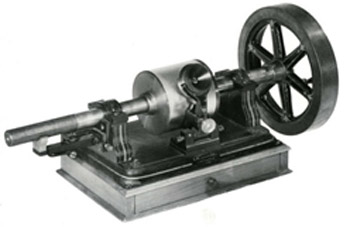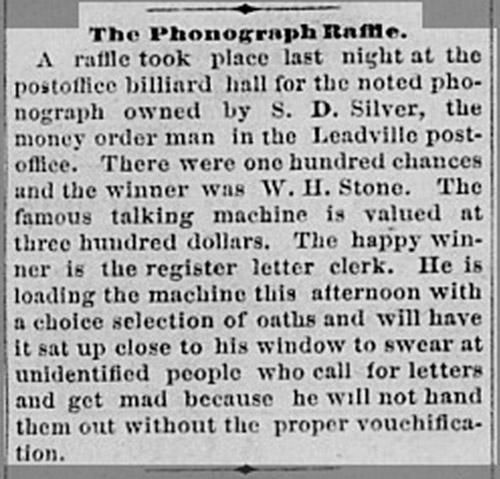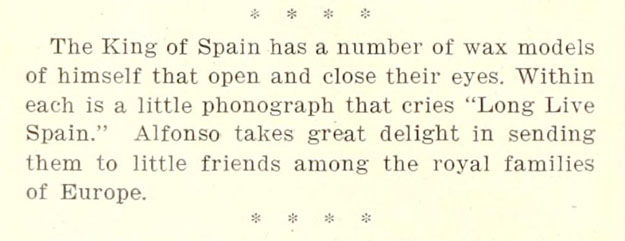Believe
it or Not!

Miscellaneous
Phonographia Factolas
.
By Doug Boilesen, 2020
Advertising by its very nature can
push believeability to its boundaries. Early phonograph advertisements,
such as ones describing phonograph records as producing sound "only
life itself can compare with" or picturing artists actually
performing in your own home, exemplify the phonograph industry's
creativity in promoting the world of recorded sound.
Like advertisements, the following
Factolas are to be believed (or not) and are here because they are
miscellaneous, meaning they don't fit into other phonographia galleries
or are a "first" of something, or are simply a piece of
ephemera seting the record straight.
As the saying goes, "Let the
PUN-ishment fit the crime."

Postmarked May 9, 1907
(PM-0456)
FACTOLA, October 26, 1877 - The
first telephone in the White House was installed for President Rutherford
B. Hayes. The White House was given the telephone exchange number
"1." The
Telephone Comes to Washington: George C. Maynard, 1839-1919
Richard T. Loomis.
.
FACTOLA, July, 1879 - The first
phonograph used in a United States post office as customer communication
support was in Leadville, Colorado.

Bergmann Exhibition Tinfoil
Phonograph sold in per contract with the Edison Speaking Phonograph
Company. (Courtesy René Rondeau)
.
It is known that one of Edison's 1878
tin-foil phonographs (a Bergmann Exhibition model phonograph) was
purchased in September 1878 by a Mr. S. D. Silver who lived in Leadville,
Colorado (elevation 10,151 feet). (1)
Silver exhibited the phonograph around the country and later raffled
it, reportedly won by the Leadville post office letter register
clerk W. D. Stone in July 1879. The clerk was said to have recorded
a "choice selection of oaths" and then placed the phonograph
in the Leadville post office window where it could "swear at
unidentified people who call for letters and get mad because he
will not hand them out without the proper vouchification."
.

The Daily Chronicle,
Leadville, Colorado, Thursday Evening, July 31, 1879
.
FACTOLA, November 1 or November
8, 1888 - The first attempt to record a public speech by means
of the phonograph was made Thursday evening at a democratic rally
in the Park rink in Orange, New Jersey. Eighteen cylinders were
used with 'slight breaks" between changing of the cylinders.
The cylinders were said to each last about seven minutes. The portions
of the speeches taken were nearly two hours long. The phonograph
was operated by Theodore Wangemann and an assistant, both connected
with the Edison Laboratory.
From New York dispatch and printed
in the Dannebrog Sentinel
on Saturday, November 10, 1888, p. 2.
.
.
FACTOLA, April 20, 1891 - First
attempt to introduce a new way to speculate in stocks using the
Phonograph to place orders.
Reported by San Francisco's The
Examiner, The Public Stock Exchange was incorporated in December
1890 with by-laws that stated "stocks may be bought and sold
by oral expression or by the reannouncement of orders on a phonograph
in the exchange room. When a phonograph is used to make the bids
and offers it shall be done aloud so that all may hear it and a
record made at once of each offer to buy and sell on a blackboard
in the Exchange room. The phonograph thus used is designated the
"Main Phonograph."
The Attorney-General filed a complaint
to have the Public Stock Exchange charter forfeited since the Main
Phonograph can be manipulated. See On
the Phonograph, The Examiner, April 20, 1891 for
the original newspaper article.
See BOGUS
STOCK GAMBLING." Chief Crowley Says He Will Raid
the Phonograph Game for details about creating the prices
for stock quotations on the phonograph, playing them back and then
recording those quotes on the board. The Examiner, November
7, 1891
See The
Phonograph Leak for an example of how the phonograph speculation
game, aka clock game, operated and went wrong for the San Francisco
Public Stock Exchange. The
Examiner, January 19, 1892
.
.
FACTOLA, April 13, 1893 - The
horse "Phonograph" came in first at the Elizabeth race
track paying five to one (reported by The Phonogram, March-April
1893.

FACTOLA, April 1898
- Thomas A. Edison will not talk into his own phonograph. He
has persistently refused and gave as his reason: "It would
make me sick with disgust," he explained, "to see placarded
on phonographs everywhere I turn: 'Drop a nickel in the slot and
hear Edison talk.' No, no; noe of that for me."

"The Anecdotal
Side of Edison as told by his intimate friends," The Ladies'
Home Journal, April 1898, p. 8
FACTOLA, November 1898 - The
Edisonia Co., of Newark, N. J. included their telephone number in
their November 1898 The Phonoscope ad: TEL. 2232 "B".
This was the first advertisement in The Phonoscope to have
a telephone number listed.

The Phonoscope,
November 1898
FACTOLA, January 15, 1906

FACTOLA, July 18, 1906 - Thomas
Edison was given a solid gold cylinder record by the Jobbers of
the United States and Canada at the National Phonograph Company's
"1906 Edison Phonograph Jobbers" event. The gold record
was then played on an Edison Triumph Phonograph and the following
address was heard:
Mr. Edison: The record of pure gold
which addresses these words to you is a gift from the Jobbers
engaged in the distribution of the Edison Phonograph and Records.
They have come from the East, the West, the North and the South
of this fair land of ours. They are your loyal and admiring friends,
your ambassadors of commerce, whose mission it is to distribute
your product to the four quarters of the globe. By the touch of
your colossal inventive genius you have created industries giving
employment to countless thousands the world over. The wheels of
commerce occupied in the production of your inventions sing a
never-ending song of praise to your magnificent achievements.
To the seven existing wonders of the world you added the Phonograph,
which is the eighth wonder of the world. It speaks every language
uttered by human tongue, and in the field of language study it
is the greatest educator the world has ever known. With song and
story it will continue till the end of time to entertain the multitudes
of the earth who place the name of Thomas A. Edison at the head
of the column of the world's greatest captains of industry. (EPM,
August 1906)

The Edison Phonograph
Monthly, August 1906.
"The stand supporting the gold
record presented to Mr. Edison is made in solid sterling silver,
ornamented with solid gold inlay and surmounted with three beautifully
modelled figures, representing music, art and progress. On the sides
of three panels are imbedded a portrait of Mr. Edison and appropriate
inscriptions of the event." (Ibid.)
FACTOLA, January 1907 - "A
phonograph being heard through a phonograph is presented in the
Sterling record, entitled "The Absent Son."

The Talking Machine
World, January 15, 1907
FACTOLA, August 15, 1908 -
"Probably the highest graphophone store in the world"
is in Silver Plume, Colorado "over 9,000 feet above the sea
level..."
This 'store in the clouds' factola
comes from a talking machine industry trade magazine that was specifically
referencing a Columbia Graphophone store (and even qualified
it with "probably.") Other phonographs might have been
playing at higher altitudes but in 1908 this probably was the highest
graphophone store in the world.
.

The Talking Machine
World, August 15, 1908
.
FACTOLA, April 1909 - The royal
Swedish academy presented Thomas A. Edison with the Adelskiold gold
medal for his inventions in connection with phonograph and the incandescent
light.
.

The Juniata Herald,
April 14, 1909
.
FACTOLA, 1917 -
Phonograph apparatus in World War I used to record heart beats of
a French soldier for analysis of physical stamina.
An recording appartus during World War
I made a record of the heart beats of a soldier in the French army.
The Pathe Phonograph Co. and the French government hoped recordings
would provide detailed information of the physical stamina of the
soldiers in the French army. "The minutest irregularity in the
heart beats is instantly detected."
.

The Talking Machine
World, Feburary 15, 1917
.
FACTOLA, March 1918 - The play
"Why Marry?" is believed to be the first time the complete
play has been recorded on talking machine records by all actors
in the play.
.

The Talking Machine
World, March 15, 1918
.
FACTOLA,
October 1918 - The only authentic sounds of the First World
War are said to be the recording of the gas shell bombardment by
the Royal Garrison Artillery, 9th October 1918, preparatory to the
British Troops entering Lille, France.

"His Master's
Voice" 12" 78 RPM record by the Gramophone Co., Ltd, 1918
This record from ValueYourMusic
website was submitted by Allen Koenigsberg who also cautioned that
"there may be some controversy over the circumstances of this
recording."
ValueYourMusic notes "This
record was made by HMV’s top Recording Engineer, Will Gaisberg,
outside Lille in France on 9th October 1918 and rushed back to England
for issue, but by the time it saw release the Armistice had been
signed and, consequently, sales were very poor."
According to The
Church of the Epiphany, "by the time the recording was
completed, the war was over. Gaisberg had been slightly gassed during
the expedition, and fell victim to the flu pandemic and tragically
died a month later in November 1918."
.
FACTOLA, April 1920 - The first
record lifter on the market - The Vacuum Record Lifter "raises
the record without touching the tone arm..."

The Talking Machine
World, April 15, 1920
.
FACTOLA, 1956 - Phonograph
records were put on cereal boxes as a premium to cut-out and
play. According to mrbreakfast.com
and Discogs
the first records were on General Mills' Wheaties cereal boxes in
1956, 78 RPM cut-outs for Walt Disney's Mouseketeer Records of Chip
'N Dale performing "Ten Little Indians" and "The Laughing Song."

.

1956 The
Laughing Song 78 RPM Cut-out record from box of Wheaties
FACTOLA, 1962 - On January
1, 1962 John Lennon, Paul McCartney, George Harrison and Pete Best
auditioned at Decca's London studio, formally known as a "commercial
test." They are reported to have recorded fifteen songs. About a
month later, Decca rejected the Beatles. The executives felt that
"guitar groups are on the way out" and "the Beatles have no future
in show business". (The Beatles. (2000). The Beatles Anthology.
San Francisco:Chronicle Books. ISBN 0-8118-2684-8.)
On 6 June 1962, producer George Martin
signed the Beatles to Parlophone.
The rest is history with Decca's business
mistake ranking high in the history of recorded sound involving
a loss of billions of dollars. Wikipedia, Beatles
Decca Audition (12-2-2023).
.
FACTOLA, 1964 - A circa 1910
gramophone horn was being used for the cover of a storm cellar's
air vent in Cotesfield, NE.

.
.
FACTOLA, 1971 - "Would
you believe..." the Columbia Record & Tape Club
offered LPs and 8-track cartridges and tape cassettes
and 7" reel-to-reel tapes as new record club options
in the 1970's?
The phonograph industry has shared
its position of providing recorded music to consumers as new technologies,
formats and listening options have evolved. In the 1990's CDs would
be another recorded music option and in 2001 Rhapsody would introduce
"the first streaming on-demand music subscription service to
offer unlimited access to a large library of digital music for a
flat monthly fee." (see Wikipedia).
The evolution of the phonograph's
revolution has continued into the 21st century but through it all
the phonograph and its records continue to revolve. The Phonograph
Lives!

Columbia Record
& Tape Club, 1979
.
See ClickAmericana
for more examples of Record Club's history and promotions

1971 Order Form for
Columbia Record Club
.
FACTOLA, March 2016 - Walt
Whitman did not record his poem "America" or make any
phonograph record.
"Famous" voices such
as Mark Twain, Robert Browning, P. T. Barnum, Florence Nightingale,
Wm. Gladstone, and Alfred Lord Tennyson recorded on wax cylinders
in the very early days of the phonograph.
For many years a recording
of Walt Whitman's poem "America" was said to have been read by Whitman
himself. Current research (up to February 2023) concludes that the
Walt Whitman recording was not made by Whitman. According to Allen
Koenigsberg it is unknown who made the recording. "The mystery will
probably never be solved to everyone's satisfaction, but I think
it is safe to say (for now), that the famous American poet who "sang
the body electric" only did so on the printed page." (Allen Koenigsberg,
"The
Gramophone Cylinder of Walt Whitman - Hoax or History," The
Antique Phonograph, March 2016, p. 27).
The First Kinetoscope
Parlor
FACTOLA, April
14, 1894 - The first commercial exhibition of Edison's Kinetoscope
motion pictures opened in the first Kinetoscope parlor, a building
and storefront at 1155 Broadway, New York City.

First Day of Issue for
stamp celebrfating 50th Anniversary of Motion Pictures on April 14,
1894.
A bust of Edison was
located in the front section of the Kinetoscope parlor on opening
day but was soon removed. According
to Alfred O. Tate, Edison's Private Secretary, a few weeks after
the opening "I received a message from Edison asking me to
remove it. He thought it undignified."
It is unknown what Edison
meant by "undignified" but ironically the first occupant
of the 1876 building's storefront had been John
Rogers, the famous artist known for his popular "Rogers
Group" pieces and who was commonly called the "people's
sculptor." Rogers had his first floor studio at 1155 Broadway
building from 1876 through 1879.

"The Photograph"
- a two-piece sculpture set in the Rogers Group, 1878.
.

Interior of first Kinetoscope
parlor, 1155 Broadway, New York, in April 1894 (as seen in History
of the Kinetograph Kinetoscope and Phono-Kinetograph) by
W. K. L. Dickson and Antonia Dickson, p. 53 ©1895.
In the article "The
Birthplace of Movies" by Christopher Gray (New York Times,
February 9, 1992) Gray wrote that the Kinetoscope parlor "at
the southwest corner of 27th Street was a neo-Grec style building
built in 1876 where Rogers would live until at least 1879.
Gray also noted that
"the Kinetoscope was superseded only two years later by projected
motion pictures, first exhibited in 1896 at Koster & Bial's Theater
on West 34th Street...A turn-of-the-century street view shows the
27th Street building with extensive signage for the Edison phonograph
-- presumably the Kinetoscope operation was open for only a year
or two."

"The Traveling
Magician" advertisement, March 30, 1878 Harper's Weekly
showing 1155 Broadway as the address for the John Rogers studio.

The Traveling Magician,
John Rogers, 1877 (Courtesy
New York Historical Society)
Signed at proper right corner top
of base: "JOHN ROGERS / NEW YORK / 1877" -- 1877 was of course
also the year that Edison completed his Phonograph ( December
6, 1877).

Phonographia
Last revised February
10, 2023.
|

























